.
.
photo by Michael Lionstar
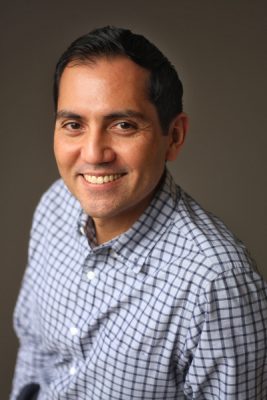
Nate Chinen, author of Playing Changes: Jazz for the New Century
.
___
.
…..Nate Chinen has been an outstanding and now longtime contributor to the jazz discourse, most prominently as a New York Times critic for twelve years, and as a frequent columnist for Jazz Times. In 2003, he co-authored Myself Among Others, the autobiography of the most eminent impresario George Wein that was named that year’s “Best Book About Jazz” by the Jazz Journalists Association. That organization has also awarded Chinen the Helen Dance-Robert Palmer Award for Excellence in Writing twelve times.
…..Currently the director of editorial content for WBGO in Newark, New Jersey, his work includes sharing his vision for jazz music on the station’s website, on the syndicated program Jazz Night in America, as well as on NPR Music. As a writer and critic, his advocacy and voice for the music is without doubt among his generation’s most prominent.
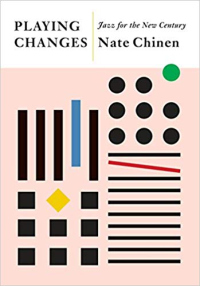
…..In his 2018 book Playing Changes: Jazz For the New Century (recently released on paperback), Chinen has written twelve meaningful and entertaining essays connecting readers to jazz music’s rich and spirited future, present, and past – its important contributors, the direction it is growing, and how it is organically getting there. The book, according to Herbie Hancock, is a “fascinating read” that shows Chinen’s “firm support of the music and belief that the changes taking place within it will continue to serve it well – solidifying jazz as a global mode of communication without bounds.”
…..In a wide-ranging July 18, 2019 conversation with Jerry Jazz Musician publisher Joe Maita, Chinen talks about his book, and shares his uplifting insights on the state of jazz music.
.
*
.
Visit the publisher’s website for the book
.
.
_____
.
.
.
Photo by William P. Gottlieb/Library of Congress
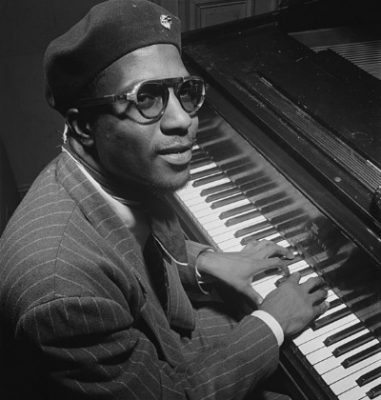
Thelonious Monk, New York, c. September, 1947
.
___
.
“As long as people have been talking about jazz, they’ve been talking about where it’s going. The conversation rests on presumptions of forward progress and collective striving. But while some musicians have embraced the premise, others refused to play along. A well-meaning interviewer once asked Thelonious Monk where he thought jazz was going, and the pianist replied: ‘I don’t know where it’s going. Maybe it’s going to hell. You can’t make anything go anywhere. It just happens.’“
– Nate Chinen, from Playing Changes: Jazz for the New Century
.
.
_____
.
.JJM. Are you a musician, Nate?
NC. Yes, I trained as a jazz drummer, and I was very serious about it during my teens and twenties, but I didn’t go to school for music, partly because all the jazz musicians that I knew counseled me against it. It was the “something to fall back on” argument, but that also had to do with the fact that I was always interested in writing, and I was always a reader and an observer. So, even the jazz musicians I knew recognized that it would be good for me to be a well-rounded person in my education, but because I knew that I at least wanted to give it a chance, I chose my college partly on the existence of a jazz scene, which is one big reason I went to school in Philadelphia. I quickly fell into the Philadelphia jazz community, initially as a player. I sat in on my first night in town, and I made a lot of friends and collected some mentors along the way. I felt welcomed by that community, and began writing about it. So, my whole identity as a critic really formed out of being a part of this small but vibrant jazz community.
JJM. Was there a book or a record album liner notes that you may have read as a young man that kindled your interest in jazz music?
NC. The reading was simultaneous with the listening, and liner notes were key. I came of age as a listener in the mid 1980’s to the beginning of the 1990s, which saw the first CD reissue boom. This was the era of the Columbia Records Jazz Masterpieces series, which was related to the Columbia House Record Club. My dad signed me up for that, and it was basically a one-album-a-month deal. Those reissues were not all that lovingly made, and there are all kinds of issues with the sound transfers, but the fact remains that as a 13, 14 year old kid, I was listening to the Hot Fives and Sevens. When you are that age and have no money – this is obviously before the Internet – that album is your one new album for the month.
I still haven’t discovered who in the catalog department at Columbia did this work, but whoever it was did a pretty good job. I can tell you that some of the first titles were Kind of Blue, Dave Brubeck’s Time Out, Ellington at Newport, Heavy Weather by Weather Report, Hot Fives and Sevens, and Monk’s Dream. So, the first time I heard Monk was because I got Monk’s Dream in the mail, and that then kindled something, and I thought, ‘I have to check out more of this guy.’
JJM. What kind of music did your mom and dad listen to around the house when you were growing up?
NC. Before I was born, my parents were entertainers. They were both singers, and had separate careers before they met each other, and once they did, the two of them formed an act together and toured the country. My dad was actually a big band singer in the Sinatra mold, and my mom was more of a lounge-style singer, very “Nancy Wilson-esque.” They were both successful in their spheres, and when they formed this act it was during the end of the heyday of the nightclub and lounge era. Their band played custom arrangements of all kinds of top 40 hits, which at that time was Jesus Christ Superstar, Blood, Sweat and Tears, and those early 1970’s horn bands. All the musicians in their bands were jazz musicians who couldn’t find work playing jazz, so while they worked in this show band, they would sneak all this really hip stuff into the arrangements. So, my parents were both quite jazz literate – not in a jazz connoisseur way but in a show biz way that used to be much more common. They saw Duke Ellington at Disneyland, they shared a bill with Buddy Rich…
JJM. Funny, I saw Buddy Rich at Disneyland in a small outdoor setting at some hamburger restaurant, and I saw Basie at Disneyland also, who played with his entire band at some outdoor arena in Tomorrowland.
NC. It is interesting to think that Disneyland was so hip. What would it be now? It would be a Disney-branded lip-sync act of some kind.
JJM. I guess that’s probably right.
NC So, my parents would bring me to their gig; my earliest memories are of bouncing on my grandmother’s knee at the bar in a nightclub. I grew up around rehearsal halls and clubs, so all of that was very familiar to me. I’ve thought about this a bit, especially in the last year or so, when people have asked me about my story, and I think it was actually formative — not only because I heard a lot of music as a kid, but also in that I’m different from a lot of other jazz critics, because my primary relationship to the music in my youth was seeing it live, not listening to albums or collecting them.
Many critics have the heart of a collector, and for me, it is quite disentangled from that. There weren’t really any great record stores in Honolulu, where I grew up, but there was at the time, in the late 1970’s, a thriving entertainment industry, and I was always being dragged along to these gigs. I loved watching the musicians set up and play the gig, then pack up and hang out afterwards – all of that was very real to me. On some level it had to have had an impact on the way that I perceived the music. I love albums, and I love collecting albums. I fixate on recordings as much as anyone, but maybe somewhere in the back of my head I still seek out the sound of a band.
JJM. It is fascinating that among your first memories as a child is you at a live music performance, which became who you are professionally, spending so much of your waking hours in clubs, and then articulating the experience to readers…
NC. It’s a lot more full circle than I would have anticipated. It’s funny, because I really didn’t psychoanalyze myself or even put this together until quite recently, partly because people have asked me what motivates me as a critic, and how that might be different from some other examples, and I think there is something to it.
JJM. Countless wonderful jazz histories and biographies have been written. A favorite of mine – which I read sometime in my 20’s – is Art Pepper’s Straight Life, which got me curious about him and his music, but also sent me digging deeper into the culture of jazz and the complexity of its personalities. Is there a book on jazz that had that impact on you?
Art Pepper’s 1979 autobiography (co-written with wife Laurie)
.
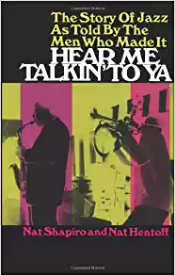
A paperback edition of the 1955 Nat Hentoff/Nat Shapiro book Hear Me Talkin’ to Ya
NC. Liner notes were important. I read and studied all those notes on those Columbia albums and others that I bought, so I knew names like Ira Gitler, Nat Hentoff, George Avakian. The first book I remember being infatuated with was the oral history by Nat Hentoff and Nat Shapiro, Hear Me Talkin to Ya, which was like a set of dispatches from another world, just to hear these musicians telling stories. I was so drawn to that. I fell completely in love with the Art Pepper book, but I think I read it as a freshman in college, so I wasn’t into that quite yet in high school. While I was in high school I read B.B. King’s autobiography, which was a David Ritz co-production.
Criticism didn’t really come alive to me until I was in college. I understood why liner notes were important, but I wasn’t really familiar with the work of some of my heroes – like Gary Giddins, Francis Davis, Stanley Crouch, and that generation of critics, who have been very influential for me. They were all writers that I encountered in college.
JJM. Regarding your own book, Playing Changes, I like the jacket cover artwork quite a bit. Can you talk a little about how you came to decide on this art? I assume you collaborated on this?
NC. To be perfectly honest, I did not collaborate on it. The jacket designer, who I am eternally grateful to, is Kelly Blair, the art director at Pantheon Books. Her work is very well known, and you can see many of her book jackets at kellyblair.com.
I had a fantastic editor, Erroll McDonald, with whom I shared a vision for the book. He gave me all the room I needed and did not impose a lot of restrictions, but he was very useful as a sounding board, and provided really great feedback. Erroll is well known in the literary world for many reasons. Among them is the fact that he’s one of the few African-American editors at his level in publishing. He has a lot of history with Toni Morrison – she mentored him, and he subsequently became her editor.
Erroll told me he gave Kelly two pieces of instruction when it came to the cover: one was that he wanted it to feel modern, and the second was that he wanted to avoid all the jazz book clichés. Now, you can interpret that however you want, but to my mind what that conjures is the kind of Herman Leonard photo with smoke curling against the dark background, which is an iconography that I love, but it isn’t the message that we wanted to convey with this book.
So Kelly went to work, and the design that ended up on the jacket of the book is literally the first thing that they sent to me. And I think she created something ingenious. First of all there is that baseline color called “millennial pink,” and then there are four sectors to the illustration. Within each sector is a geometrical grid, with one piece of it in color sort of breaking away, giving it this implication of movement and difference. In a way that is a metaphor for what this book is about – musicians who are breaking away in a certain respect, articulating a new reality, and expressing themselves as artists and as people while also coming out of a lineage, still very much connected to the tradition. All of that is very subtly communicated through the details on the cover. I’m not sure how many people actually think about that, but for me it really worked. I owe Kelly quite a bit because I have noticed that a lot of bookstores display the book facing out, and that has everything to do with the striking genius of her design. The New York Times Book Review listed this as one of the top ten book jackets of the year…
JJM. Congratulations!
NC. Thanks. This has everything to do with Kelly’s achievement, and I am just fortunate enough to have been a beneficiary of it.
JJM. Your book is uplifting and forward-thinking. You hold a lot of hope for the music, and it takes on this notion that so many people – particularly people my age (65) and older – who are accustomed to hearing the “jazz is dead” argument. You write that jazz music is in a “present moment of abundance. Do you feel that jazz is experience a new “golden age”?
NC. I actually wrote an editorial for the New York Times at the end of the year that specifically addressed that question, after the Times op-ed page asked me to write an opinion piece arguing that jazz is in a new golden age. What I gave them instead was a piece that articulated my deep ambivalence about that whole framework – not only the idea of a new golden age, but the idea of a “golden age” at all. To me, it is a framework that limits more than it unlocks. (You can access the piece by clicking here)
So, that is one part of my answer. To address the rest of your question, I’m glad you find the book uplifting, because that was intentional. I wanted to push back against a tone of hopelessness that often comes into the room when we begin talking about the fate of the music. It’s very easy to get alarmist or despondent about jazz’s marginal foothold in our culture. It’s difficult to be a jazz artist. I won’t say it’s difficult to be a jazz fan, but we are an endangered species in a certain way, just speaking of pure numbers. With that comes a feeling that the music we love is vanishing, or a kind of toxic nostalgia. Now, I’m not always against nostalgia, but when that’s the whole tenor of the conversation, I think it is self-defeating. During my time as a columnist for Jazz Times, and as a critic for the New York Times, I encountered so much that gave me hope, and so much that indicated to me that the music really is in a healthy place aesthetically.
That leads me to the second point, which is that things really do feel different in the broader jazz discourse, especially as it relates to that most elusive thing, which is developing a young audience. For as long as I have been involved in the jazz community, that has always been the hand-wringing complaint; where are all the young people, and especially where are all the young people of color? Where are the female jazz fans? Well, we happen to be in a moment now, during the last five years or so, when a lot of that has opened up. So, depending on who you talk to, you could say, “Oh, I’m into jazz,” and you don’t necessarily get that kind of befuddled nod and then that slowly-backing-out-of-the-room response. Now, you might hear someone say, “Oh, really? I like Esperanza Spalding,” or, “Really? I just saw Kamasi Washington.” Now, we can quibble about how much that is a jazz story, and that’s something I attempt to address in the book, but to me it’s all to the good, because if we have people who are reclaiming the message of the music, or just articulating this idea that it is still alive and well, that’s good for everyone.
JJM. There is an unbelievable wealth of great talent performing the music today. It’s inspiring to see such young musicians entering a field of music that has so little to offer commercially, and they seem to say, “To hell with it. I’m not in it for the money, the art is what is important to me.” This isn’t unique, of course, but it is always uplifting to see artists of this caliber playing the music and expanding its sound and reach. Also, as you write in the book, the idea of having to define jazz music, or play within boundaries is beginning to feel outmoded. Everything from ECM to D’Angelo to Wynton Marsalis is folded within jazz –maybe there is a model for musicians to break through and find that right balance of artistry and revenue.
NC. It is certainly happening for some folks.
JJM. You wrote, “…to a striking degree, avant-garde practice and formal invention have now insinuated themselves into the mainstream, shifting the music’s aesthetic center.” How have some of the institutions of jazz responded to this? For instance, how has WBGO, where you are currently employed, and Jazz at Lincoln Center responded to this?
NC. With Jazz at Lincoln Center, just look at their programming and you see evidence of this. It wasn’t too long ago that it was big news, for instance, when Joe Zawinul played there with his Zawinul Syndicate. Something like that was a shocking deviation from the norm, and now it is no big deal. Their new season includes Wynton’s Abyssinian Mass, as well as a 50-year ECM celebration, which will include not only Ravi Coltrane and Bill Frisell, but also Vijay Iyer and Meredith Monk. There is real willingness to just open up. They still call it the “House of Swing,” but that epithet feels a little less exclusive now than it might have before.

With respect to WBGO, there are different ways to look at it. We have a diverse assortment of announcers on the air, and while Michael Bourne is not necessarily going to play someone like Robert Glasper, you will hear Robert Glasper on the station. Gary Walker plays him. So does Nicole Sweeney. And Jazz Night in America – which is a co-production of WBGO, Jazz at Lincoln Center and NPR Music – has featured many of the big-name hybridists of the moment. Whether it’s Glasper or Kamasi or Mark Guiliana, Jazz Night is there, while also spotlighting Lou Donaldson, Abdullah Ibrahim, and the more old-guard, living heroes. So there is this “big tent” understanding.
It is interesting to me, because there is this generational thing going on. I am in my early 40’s, and I often find myself straddling two generational cohorts. Without trying to generalize too much, people from your generation often have a self-awareness of the divisions between jazz and rock and other music genres, and these divisions are a little bit more firmly inscribed than I see them. But I get it. I grew up with that set of values, and I grew up with that criticism. On the other hand, listeners who are younger than me, who are now in their twenties, don’t feel these divisions, to the point where I actually feel myself wanting to push back and say, “Well, it’s not all jazz.”
So, in some ways what I wanted to do with this book was to articulate my own vision and call things as I see them, but also to put these different factions into dialogue in some way. I’ve had younger musicians and readers comment to me that they are really grateful for the history lesson, because they didn’t understand just how fraught these terms were during the height of Wynton Marsalis’ “agenda,” for lack of a better word, when he was issuing a lot of pronouncements that drew a line in the sand. That’s ancient history to a lot of people who just weren’t around at that time. Kamasi is a good example, right? I wanted to grapple with what he means, and how he means different things to different constituencies.
JJM. I grew up with the rock era dominated by the Beatles and the Stones, but also with the music of Miles, Monk and Coltrane. Your book quotes Brad Mehldau as saying; “We’re the generation of Quentin Tarantino and Beck and this mash-up of stuff: listening to Bird and Monk and Coltrane, but also being on the road and listening to Soundgarden and Alice in Chains, or going to a Sonic Youth concert.” People my age don’t always think about that – the jazz legends connect the generations, but the pop music does not. Clearly these differing musical listening experiences impacts the way the artists from differing generations create their music.
NC. Related to that is an observation I make later in the book that felt important to me, and I hadn’t seen anyone else make it quite this way. A chapter called “The New Elders” has to do with the idea that if we place musicians your age, 65, at the youngest end of a generation, that group would include all of the musicians who broke the rules with respect to style-blending and “this meeting that.” That group could include, for example, the musicians who were in Miles Davis’ circle in the late 60’s and the early 70’s and who are now in the pantheon. And because jazz has such a strongly inscribed culture of reverence for the elders, which is something that I hope never goes away, it means something when a torch is being passed from a generation that grew up playing in big bands and was forced to respond to the seismic change of bebop. That’s a fundamentally different experience than having a generation who, when they were in their late teens, idolized Cream and Jimi Hendrix and Sly Stone and really tried to incorporate that into their jazz experience. It is just an existential change for the music when your elders have already done all of that, and the permissions around the ideas are different.
So, when we talk about how uplifting or sanguine or hopeful I am in this book, some of it has to do with the fact that, yes, there is all this new stuff happening, and there are all these new amalgams and approaches — but at the same time, we are still turning out people like Christian Sands, who can swing anyone off the bandstand and know every standard. That’s partly due to the fact that we managed to build a pipeline between these generations. Christian Sands was mentored by Dr. Billy Taylor. Well, Billy is gone, but I think Christian is going to take it upon himself to make sure that that is still there.
JJM. In the opinion of New York Times critic Peter Watrous, jazz/rock fusion – that came mostly out of Miles’ circle of the 60’s and 70’s – impacted these artists’ position as what you would call “elders.” Watrous writes, “By following Miles Davis down the fusion path, artists like Shorter, Hancock, and Corea had abdicated their place in the jazz pantheon, creating the vacuum that Wynton Marsalis had rushed in to fill.”
NC. Any good critic is in part a good historian. I am proud of the part of me that is a student of jazz history, and for connecting the dots in the first chapter of this book. It always struck me that the conversation around Wynton was so polemical, and so much about choosing sides, that it rarely got to a level of nuance that I thought was where all the action was. I will put all my cards on the table: I came up at a time when he was on the rise, so Wynton Marsalis was one of my first living jazz heroes. He is someone whose albums I was buying as they were coming out. I was also buying Art Blakey albums that he was on. So, I have a formative relationship with Wynton, and I remember what it felt like to have him be such a star.
But, because I spent a good amount of time with George Wein, co-writing his book and doing a lot of research around the New York Jazz Repertory Company and everything that happened in the 70’s, I knew enough to understand that there was a larger story about the conservation movement and where it came from, and why it happened, and what the implications were for the industry, and for the reception that Wynton encountered. Wynton Marsalis would have become a great success in the music no matter what, but there was an extraordinary convergence of conditions that made it possible.
I felt the same way about Kamasi Washington, in terms of the cultural conditions. What was the thing that his emergence spoke to? That was the big puzzle for me, because I knew I wanted to open this book with a conversation about the conservation movement and the industrialization of jazz-as-nostalgia that occurred in the 80’s and 90’s, but it would be really weird for me to begin a book about jazz in this century by jumping back 30 or 40 years. So, there was a lot of structural puzzling over what I had to do, and my sleight of hand is to open the book with Kamasi Washington, but really, he’s the gateway to a conversation about jazz repertory and the rise of Wynton and the emergence of the Young Lion movement, because that is setting the necessary groundwork for everything that follows.
JJM. Chapter Three, ”Uptown Downtown,” is a terrific history of jazz in New York, as Jazz at Lincoln Center emerged as an institution known as the “House of Swing,” while at the same time experimental artists like John Zorn and clubs like the Knitting Factory were pushing boundaries, creating polarizing factions, often times with critics, musicians and fans choosing sides. So, things have moderated since then…
NC. There is a really happy outcome for our current moment, in that musicians not only don’t see a reason to choose a side; they don’t even see why anyone would ask them to choose a side. I don’t mean everybody, but it’s really not strange to encounter a musician who is entirely fluent in bebop and the post-bop language, but who has also done the work to try and understand Cecil Taylor, the AACM, and Ornette Coleman, and also hip-hop and electronic music, etcetera. So, why would that be a bad thing, to have a musician with the most curiosity, and the broadest possible framework? And for me, as someone who likes being surprised by the music I listen to, it’s wonderful.
JJM. Miles Davis’ 1970 album Bitches Brew is an example of a recording that effectively communicated the musical and cultural complexities of that era’s moment in the world . What is today’s Bitches Brew?
NC. The difficult part of that question is that nobody today really commands the stature that Miles Davis had then. It’s not as if he was such a big star that Bitches Brew changed the world overnight, but that album really does stand alone in a certain way as a cultural artifact and a touchstone.
So, setting aside the cultural-prominence argument, I will say that my favorite album of last year does a lot of what you mention, and this is Ambrose Akinmusire’s Origami Harvest. What puts it in that realm for me is the fact that it is so voraciously hybridist, this fully metabolized musical idea that includes high-level jazz improvisation and ensemble interactions, but also experimental hip-hop and chamber strings and electronic ambient music. There is just so much in there, and there is also a really engaged and committed political dimension. So to me, that is an album that absolutely could not have been made at another time in history, and I don’t think it’s an album that Ambrose would make today. It really is a sort of moment in time, but the boldness of its vision and the utter seamlessness of its execution is exciting and compelling to me.
Another trumpeter doing this work is Christian Scott aTunde Adjuah. He is putting a lot of thought into the kinds of combinations in his music, really pushing to connect to an African-diasporic rhythmic idea and state-of-the-art electronic textures and rhythms, and a very clear and searing sociopolitical protest idea. Esperanza Spalding is embarked on a similar kind of project, though hers is more interior, and on a spiritual plane.
It’s funny, when we talk about albums that do this kind of thing, they are far more common now. In a certain way, they are the state of the art. Musicians really are trying to put different traditions into dialogue with each other, trying to innovate at the level of concept and execution. So, there are a lot of Bitches Brew’s.
JJM. Does the return to vinyl impact innovation in jazz? Do the musicians imagine their art in a different way due to this format?
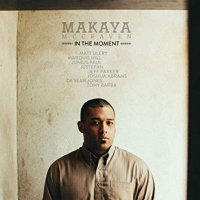
Makaya McCraven’s In the Moment (International Anthem, 2016)
(Listen to “In the Moment”)
NC. That varies case by case, but I will say the vinyl culture and the consumer base that’s really interested in vinyl from the crate-digging, hip-hop sort of perspective, I think there is something to that. Makaya McCraven is another musician I could have mentioned in the previous bunch, and he emerged on the International Anthem label as an artist who understands vinyl culture. His first album, In the Moment, is a very tactile, vinyl listening experience. I don’t even know if I have ever listened to that music in any other way – it just makes so much sense as a record. So there is definitely a connection.
So much of our music now is streamed, it’s digital, so it is hard to make any pronouncement that encompasses the lion’s share of the market, because everything is decentralized, and people have such different experiences. It’s funny, because I think jazz and classical are the only two genres of music that still have a fairly robust economy for CD’s, which have all but disappeared from the pop marketplace. So that’s interesting, too.
JJM. Your book focuses on the music and the musicians, and its place in the future. What it doesn’t address is the future of jazz criticism. What does that look like to you?
NC. The big challenge is that jazz media has really taken a hit, as other forms of media have, both in terms of coverage that used to exist at metro daily newspapers across the country, and also in the magazine business. Some of this has to do with a decline in advertising, the economic downturn of a decade ago, and the record industry losing market share to streaming services. So, it is a real complex set of issues, but what it comes down to is that the pipeline supporting younger voices in criticism is pretty banged up. So to make a living writing about music is extremely difficult – and it was difficult when I got started, but I was at least able to bounce around and have a version of the experience that others had before me. I had the privilege of being edited by Bob Christgau at the Voice, and to work at a magazine with a set of deadlines and production standards, and also filing overnight reviews for a newspaper. All of that is to say that I don’t know what the future for jazz criticism is, and I do worry because social media can sometimes flatten nuance and really create a more simplistic conversation around something.
Related to that is something that I have noticed in my own practice. Now that most of the music we write about is readily accessible to anyone with an Internet connection, or a smart phone, that changes the job description for a critic. I feel like there was a real part of the calling that had to do with being a consumer guide, telling people where and how to spend their money, and that part of it is pretty much done. Critics don’t need to do that anymore. People can sample, they can check stuff out at their own discretion, so we can advocate and cheerlead, but the way I describe it is that I feel that my job description has shifted from “gatekeeper” to “guide.” So the role of criticism can be to put things in context, and to help you figure out what it is you are hearing, and to try to draw a frame around something, or to connect the dots, or to create a dialogue with readers along the lines of: “Here is a track that you can listen to right now. This is what I noticed about it. What do you hear?” It is a cool way of creating a dialogue with the readership because it’s taking advantage of the tools we have.
All of that is part of the picture, but some of it is informed, surely, by that fact that I no longer work for a newspaper – I now work for a multimedia entity that’s primarily known as a radio station. We are in the business of bringing music to people and saying “listen to this.” So I choose what I want to get behind, and I spend a lot less time being negative about things, because it doesn’t really serve a purpose. I’ve talked about this with Gary Giddins, who felt the shift even from the 70’s to the 90’s, and he said it’s not really any fun to tell people to not listen to something that wasn’t on their radar to begin with.
JJM. The business model for journalism has been disrupted for years, and it has hit traditional arts criticism hard. The good news for you is that you used to be restricted to 300 word reviews in the paper, but I am assuming you don’t have those restrictions at WBGO, where you work now.
NC. Yes, I am in a very fortunate position now, and I don’t take it for granted. First of all, I’m surrounded by people love the music as much as I do, which is certainly new for me. Also, I don’t have an editor breathing down my neck and imposing restrictions. For example, I recently gave myself an assignment to run a feature about Billy Lester, who is a Tristano-school pianist in his early 70’s, with an album out on Newvelle featuring Rufus Reid and Matt Wilson. He is someone who a lot of people would be interested in, but almost nobody had heard of. So, I decided I was just going to write this story until I feel it’s done. I ended up writing 1400 words on Billy Lester, with one piece of playable audio in the post, and with quotes from Billy and Matt. I felt it was an interesting story, and I’ve had a nice response to it.
There are so many other examples of stuff like that, and it wasn’t that long ago that I would have had to make a series of pleading arguments to try to get the green light to run this piece, and instead I basically just decided to do it.
JJM. Do you write these pieces with the idea that they could be compiled into another book?
NC. I haven’t been thinking in that way – maybe I should. We usually publish multiple things a day, so I am mostly focused on just keeping the machine humming. I also want the next book to feel like it has a sense of purpose, and not just be a collection of previously published work. I have two small kids, and writing a book is pretty disruptive, so it is the kind of thing that I enter with full awareness of the sacrifice – not to sound dramatic – but it needs to feel really worth it, to me.
JJM. You co-wrote the 2004 book with legendary impresario George Wein, Myself Among Others, which was named the best book on jazz for that year by the Jazz Journalists Association. Was that experience something that inspires you to write another biography?
NC. Yes, there is a part of me that thinks maybe I will flex those muscles again. It was a very specific skill set, learning how to write in someone else’s voice. It’s an interesting thing to be able to do, and it took me a while to get there, but I would be surprised if I don’t do it again at some point. There are no active plans at the moment.
JJM. Is there any artist, living or dead, that you think deserves a biography?
NC. Herbie Hancock wrote Possibilities with Lisa Dickey, but I think there’s potential for a fascinating biography that is not necessarily a collaborative, authorized situation, but one that grapples with his music and what he has meant. That seems worth doing. Michelle Mercer wrote a great biography of Wayne Shorter that is in some ways an “authorized” biography, because she had such access to him. There is another way to go about it, which could also be valuable. There is a book in progress about Sonny Rollins, and I feel that there could be five more books about Sonny. People like him are such rich cultural wellsprings.
JJM. Last question…In addition to the book’s 12 essays, you conclude it with a list you call “The 129 Essential Albums of the Twenty-First Century (So Far),” which is a great guide for any curious listener wanting to catch up on critical jazz recordings of the last 18 years. What is the most compelling jazz album you have heard in the last month?
NC. I’m answering this question at the end of August, and a big portion of my listening this month involved the John Coltrane Quartet in 1964. I’m talking about Blue World, which was recorded for a Gilles Groulx film but had rarely appeared even as a footnote in the historical record. I wrote a piece for NPR Music announcing the album and getting into its back story, which is really fascinating. But setting aside the historical, I heard so much compelling music in recent weeks that I’d have a hard time narrowing it down to one. I’ll give you five. Jazzmeia Horn’s second album, Love and Liberation, is just out, and well worth hearing; she’s grown a lot since her debut, and she’s still growing, which is exciting to consider. Miguel Zenón’s latest, Sonero: The Music of Ismael Rivera, is another brilliant interrogation of cultural heritage — and another terrific document of his working band, one of the best on the scene. Nellie McKay has a new fondly-subverting-the-songbook album due in the fall; it’s called Bagatelles, and it’s a low-key stunner. Another fall release I’m excited about is SuperBigmouth, by bassist Chris Lightcap, featuring peers like Chris Cheek on tenor saxophone and Craig Taborn on keyboards. And Matana Roberts, the alto saxophonist and composer, has a new volume of her conceptual “Coin Coin” project on the near horizon — COIN COIN Chapter Four: Memphis — and there’s a lot to chew on there. Of course, I’m only scratching the surface with these. There’s a lot about our cultural moment to worry about, but on the jazz front, at least, we’re living in an age of abundance.
.
_____
.
Photo by Piper Ferguson/Courtesy Jazz at Lincoln Center
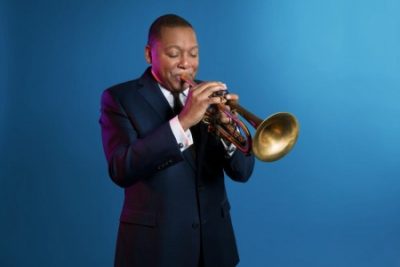
Wynton Marsalis
.
“There is no way of prognosticating jazz’s future, or even its precise trajectory, because the art form doesn’t adhere to a linear axis. The evolutionary thrust in the music is real, but it shouldn’t be misconstrued as a motive. Jazz has no inherent locomotive agenda, as some factions would have you believe, nor is it the monolith that some other factions take pains to preserve. The music’s ongoing story might best be understood in terms of a climate: volatile, variable, subject to unseen forces outside anyone’s direct control.”
-Nate Chinen, from Playing Changes: Jazz for the New Century
.
.

.
*
.
Visit the publisher’s website for the book
.
.
_____
.
.
This telephone interview took place on July 18, 2019, and was hosted and produced by.Jerry Jazz Musician.publisher Joe Maita
.
.
.








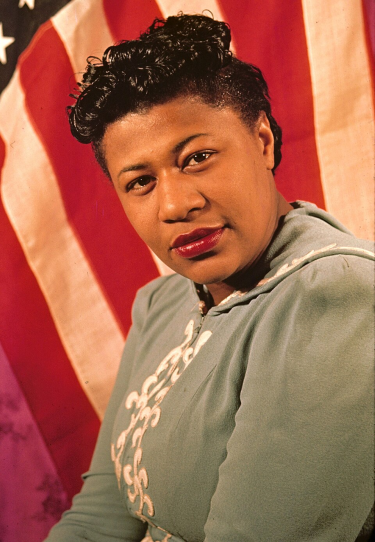














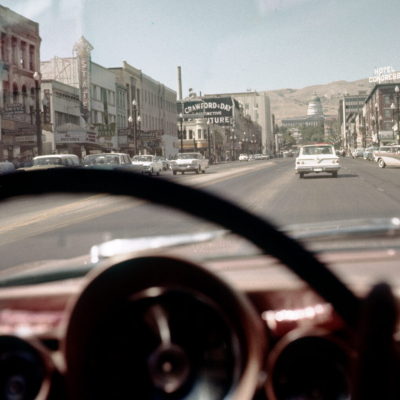















It’s regrettable that Wynton M, while a terrific administrator, remains completely overrated as a musical figure, which is supposed to be what matters. WM emerged after the main line of genuine, ‘classical’ development [Armstrong to Ornette] had ended, so cannot rank with that innovative lineage except as a pomo emblem of what had come before. It’s not his fault; it’s how history works.
Are you the same George McFetridge who played with Buddy Rich’s big band in the ’70s?